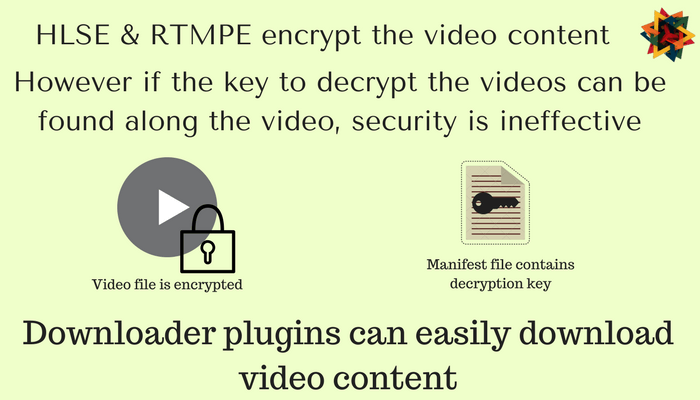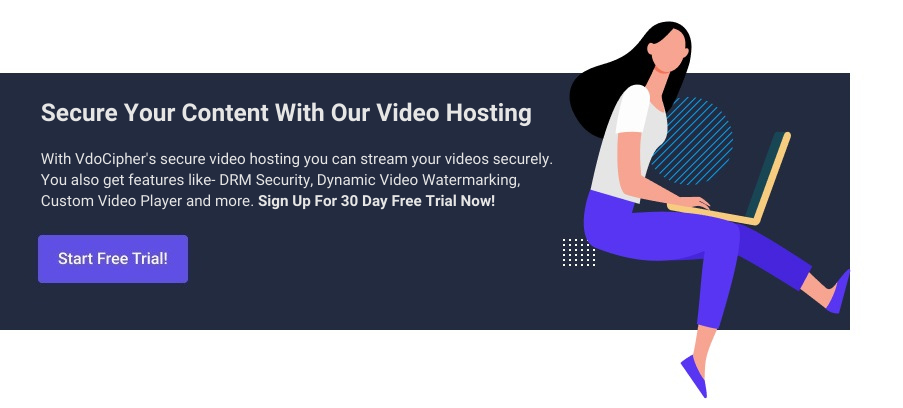This blog explains VdoCipher security technology using video encryption in detail and compares it with most other providers. Below is a video with all security features explained and compared. After the video is text explanation –
The main encrypted video streaming protocols in use by most other streaming providers are:
- HTTP Live Streaming – HLS Encryption with AES-128
- AES 128 Encryption & Sample AES 128 Encryption.
- Real Time Messaging Protocol (RTMP) and RTMP Encrypted (RTMPE)
HLS encryption, with AES-128 bit encrypted streaming, is widely marketed as a secure video encryption streaming protocol used for video protection. Indeed, certain security features have been built into these streaming protocols. However, by themselves, HLS Encrypted, DASH, and RTMPE are not sufficient to protect your content. Their security flaws lie in:
- Partial video encryption of streaming content
- Open key exchange mechanism for decryption
Explore More ✅
Secure Your Videos with Vdocipher Video Streaming Solution
VdoCipher can help you stream your videos. You can host your videos securely, and you get various features such as Video API, CDN, Analytics and Dashboard to manage your videos easily.
Why Only Video Encryption is not good enough?
The video encryption that these protocols offer is not foolproof.
Suppose, you have bought a state-of-the-art lock for your home. One that even the most masterful locksmiths cannot breakthrough. But then, well, you leave your key under the door-mat. Does your state-of-the-art lock still ensure state-of-the-art security for your home?

Many tools are widely available that exploit security vulnerabilities in encrypted streaming protocols. Tools such as IDM, Video Download Helper, and RTPMDump can even download content that has been encrypted, opening the gates for pirates to download and share your content. These tools bypass the video encryption by finding out the key to access the video, without bothering about the video encryption itself.
Although widely used, these streaming protocols are not the only streaming protocols that can be used. VdoCipher uses a modified version of the existing streaming protocols to increase video security, and minimize bandwidth usage.
How VdoCipher’s DRM Based Video Encryption Protects Your Content?
Here we explain how VdoCipher’s Encrypted Video Streaming works, and how our DRM encrypted video streaming technology is hackproof. We explain the complete workflow that our video DRM uses. Steps 5 and 6 of the video streaming workflow are the key differentiators that set us apart from the competition.
B2C or B2B marketplaces also often require features over and beyond video security. VdoCipher fulfills all major requirements for secure video hosting. The complete set of features that VdoCipher offers for enterprise video hosting may be found here.
- Upload – The video content is uploaded by the registered customer through Desktop, FTP, DropBox, directly from the server, and direct from URL. VdoCipher supports all typical video formats.
- Transcoding for Protected Streaming – At VdoCipher, we encrypt videos with DRM encryption protocol & multiple bitrates. Each device (Android, IOS, Desktop) has its own encrypted version of the file. It is in this format that the encrypted streaming takes place in. After the user uploads the video, VdoCipher converts content into an encrypted format. The video is transcoded for optimization at multiple bitrates so that viewers on networks of any quality can conveniently view videos.
- Storage of Encrypted Content – The videos are stored securely on Amazon’s AWS S3 servers using our own server-side video encryption technology, creating a double layer of protection.
- DRM Encrypted Video Transfer – Differentiator – Now the encrypted content has to be streamed to the final viewer interface, be it app or browser. Unlike many other media streaming service protocols, there are two key differences: Firstly, the entire stream (not partial) is encrypted using a non-public key whose exchange mechanism is hidden (Via Google Widevine DRM & Apple Fairplay DRM for all platforms). Others like RTMP does it partially and not fully secure. Secondly, the transfer of this encrypted content is not through direct access to the video file. There is a one time URL that is generated and the content is transferred in different chunks to optimize streaming.
- Licensing & Authentication – Differentiator – If the video has a direct video URL that can be shared, then the encrypted video streaming has completely ineffective security. This is because there can be multiple browser playback of the same video, and therefore the video can be easily downloaded. Our key service differentiator is that we have One Time generated dynamic video URLs. These URLs are accessed only through custom video embed codes, allowing licensing duration for each single video stream. This prevents any URL based sharing.
- Decryption & Playback – Differentiator – Finally, the encrypted stream content is decrypted inside the player with a dynamic key. Our DRM based key transfer protocol is fundamentally different from the public key transfer protocol in cases of HLS, HTTPS, and RTMPE Encrypted Streaming Protocols. A private key transfer between the website and our API signifies that it is not possible for hackers to decrypt our streams. The One Time video encryption that we use is theoretically and practically hack-proof. We regularly update our authentication mechanism to keep the security features up to date. Video licensing and playback are combined to generate customizable viewer specific watermarks. Within the watermark offering, IP address, Email ID and User ID can be shown as a light transparent watermark, to identify a playback session by the viewer.
- Result – Progressive High Secure Adaptive Video Streaming – Through this 6-step Video Hosting, DRM based Video Encryption, and Streaming process, VdoCipher is able to provide a progressive high-security video streaming with future buffer possible. This is also different from RTMP which does not maintain any buffer and can be quite erratic as a result. Also, once a part of a video is buffered it remains conserved, even when the viewer seeks back or forth. This ensures the fastest loading times and minimal bandwidth usage for secure video streaming.
What Is Video Encryption?
Video encryption is the process of encoding your video so that it can not be accessed by anyone without the encryption key. This stops any unwanted view or even download of the video. This puts a stop to any unwanted view or even download of your videos.
The videos are encrypted with the help of encoding software and hardware to protect the video content. When a user tries to access the encrypted video. Pirates will get an encrypted file playing via an online video player on their website or app.
What Is DRM Video Encryption?
Video encryption does a pretty good job to secure videos. Breaking encryption just by brute force might take ages to get access to the video. But there’s a catch even to it, as I mentioned in the beginning, all this encryption would mean nothing if a pirate can easily get access to the encryption key.
This is where DRM comes in, DRM protects the encryption key so that it can not be easily accessed by a malicious user. So, DRM video encryption not only helps in encrypting the video but also protects the encryption key so that a pirate can not access the video via any hack.
Detailed explanation on all VdoCipher security features (DRM encryption, url authentication, dynamic watermarking, screen capture prevention for certain device/browsers, Geo restriction). It is a lengthy video (28 min), but we bet that you won’t have any questions unanswered on video protection after watching this.
Also, feel free to check out our video encryption software, all you need to do is signup and upload your video. We take care of the encryption part, all you need to do is just embed your video on the page and voila, it’s done.
Supercharge Your Business with Videos
At VdoCipher we maintain the strongest content protection for videos. We also deliver the best viewer experience with brand friendly customisations. We'd love to hear from you, and help boost your video streaming business.




 Art says
Art says
July 27, 2020 at 9:58 pmI am interested in your service. For us it is very important the anti-piracy security. I like your dinamic watermarking. The geoblocking is also very important since we sell face to face courses in our geographic area (and we want to continue doing so) and we want to sell same courses online, so we need to block access to customers in our geographic area to the online courses
Do you offer the geoblocking feature or we must deal with geoblocking ourselves?
Thanks
 surabhi says
surabhi says
September 8, 2020 at 12:31 pmIs it possible that with your services ………live webx or zoom video can be protected from recording
 Siddhant Jain says
Siddhant Jain says
September 11, 2020 at 5:21 pmWe only protect recorded videos hosted with our system.
 Eugene Kalinowski says
Eugene Kalinowski says
February 6, 2021 at 12:34 amWhen you say “…hosted with our system.” do you mean WordPress as a webpage hosting platform?
 Siddhant Jain says
Siddhant Jain says
February 8, 2021 at 9:04 amHi, Our product Vdocipher provides video hosting and a player which can be embedded in external WordPress built sites
 Gamza says
Gamza says
July 24, 2024 at 12:43 amVdocipher protected my video to download by idm per exemple and scren recording